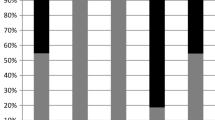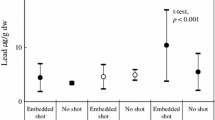Abstract.
Because consumption of lead-contaminated sediment has been suspected as the cause of waterfowl mortality in the Coeur d'Alene River basin in Idaho, we studied the bioavailability and toxicity of this sediment to mallards (Anas platyrhynchos). In experiment 1, one of 10 adult male mallards died when fed a pelleted commercial duck diet that contained 24% lead-contaminated sediment (with 3,400 μg/g lead in the sediment). Protoporphyrin levels in the blood increased as the percentage of lead-contaminated sediment in the diet increased. Birds fed 24% lead-contaminated sediment exhibited atrophy of the breast muscles, green staining of the feathers around the vent, viscous bile, green staining of the gizzard lining, and renal tubular intranuclear inclusion bodies. Mallards fed 24% lead-contaminated sediment had means of 6.1 μg/g of lead in the blood and 28 μg/g in the liver (wet-weight basis) and 1,660 μg/g in the feces (dry-weight basis). In experiment 2, we raised the dietary concentration of the lead-contaminated sediment to 48%, but only about 20% sediment was actually ingested due to food washing by the birds. Protoporphyrin levels were elevated in the lead-exposed birds, and all of the mallards fed 48% lead-contaminated sediment had renal tubular intranuclear inclusion bodies. The concentrations of lead in the liver were 9.1 μg/g for mallards fed 24% lead-contaminated sediment and 16 μg/g for mallards fed 48% lead-contaminated sediment. In experiment 3, four of five mallards died when fed a ground corn diet containing 24% lead-contaminated sediment (with 4,000 μg/g lead in this sample of sediment), but none died when the 24% lead-contaminated sediment was mixed into a nutritionally balanced commercial duck diet; estimated actual ingestion rates for sediment were 14% and 17% for the corn and commercial diets. Lead exposure caused elevations in protoporphyrin, and four of the five mallards fed 24% lead-contaminated sediment in a commercial diet and all five fed the contaminated sediment in a corn diet had renal intranuclear inclusion bodies. Lead was higher in the livers of mallards fed 24% lead-contaminated sediment in the corn diet (38μg/g) than in the commercial diet (13 μg/g).
Similar content being viewed by others
Author information
Authors and Affiliations
Additional information
Received: 9 April 1998/Accepted: 21 October 1998
Rights and permissions
About this article
Cite this article
Heinz, G., Hoffman, D., Sileo, L. et al. Toxicity of Lead-Contaminated Sediment to Mallards. Arch. Environ. Contam. Toxicol. 36, 323–333 (1999). https://doi.org/10.1007/s002449900478
Issue Date:
DOI: https://doi.org/10.1007/s002449900478




